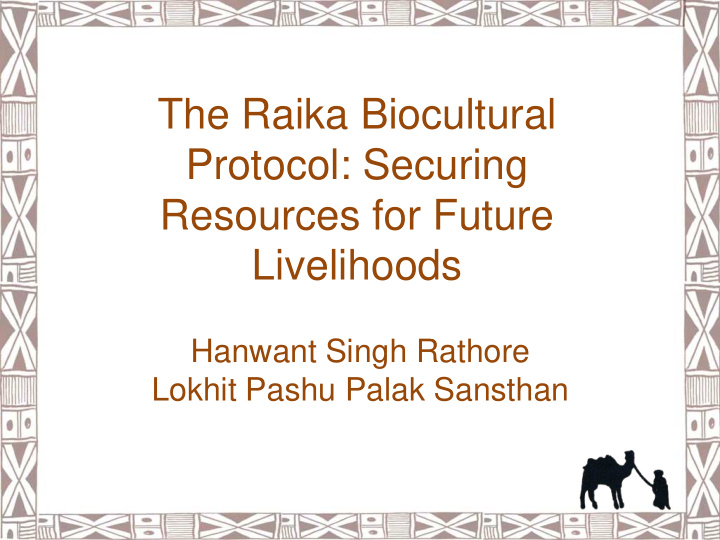



The Raika Biocultural Protocol: Securing Resources for Future Livelihoods Hanwant Singh Rathore Lokhit Pashu Palak Sansthan
Rajasthan
About LPPS • Lokhit Pashu Palak Sansthan is the Hindi word for "welfare organization for livestock keepers" • Non-profit organization registered under the Rajasthan Societies Act • Set up in 1996 to support Raika camel pastoralists in an acute crisis
Who are the Raika? The Raika are the traditional camel breeders of Rajasthan. They depend entirely on access to common property resources for grazing.
Access to crucial grazing in the forests is threatened .
Protest for Implementation of Forest Rights Act
In 2009, the Raika established a Biocultural Community Protocol, with the help of Natural Justice
Raika Biocultural Protocol • The Raika describe several breeds of livestock, incl. camel, sheep, goats and cattle that they have been herding traditionally. • They also document some of their traditional knowledge and resource rights • The Raika commit themselves to continue taking care of their resources. • The Raika BCP has been submitted to the National Biodiversity Authority and is used in the on-going struggle for grazing resources.
What is the meaning of the BCP? • The Raika Biocultural Protocol establishes the Raika as guardians of specific livestock breeds and as holders of traditional knowledge. • This is significant because recent product development efforts demonstrate the economic potential of camel based raw materials.
Camels convert extremely biodiverse vegetation into raw materials
Raw material: Camel dung
The Process
Some products
Camel dung paper : the most BIOdiverse paper on earth!
Art on camel dung paper
Raw Material: Wool
Camels give about 1 kg of wool per year, but it was previously assumed to be too coarse for creating anything attractive
Separation into coarse and fine fibres However, expert analysis revealed that camel wool contains a goood proportion of very fine, Cashmere like fibre
It can be sorted into up to 10 natural colours Wool Colours, Wool Yield Fibre Length At the time of shearing colored parts of the camel wool are separated in the following colour grades: • Peeli (yellow), • Dhoi (white), • Kali (Black) and • Kashi (mixed colors). 1 to1.5 kg per camel per year
Hand spinning can create many jobs
PRODUCT DESIGN & DEVELOPMENT: STOLES
Products received great response at export and ethical fashion fair in Paris in 2010
Benefits of Camel Milk • Camel milk can be easily digested by lactose-intolerant individuals. • Camel milk is rich in B vitamins and iron. • Camel milk has three times the amount of vitamin C than cow's milk. • Is used for treatment of a variety of diseases, including diabetes, tb, etc. •
Raw material: milk
Desert Dessert
Soap made with camel milk
Concl clus usions ons • The opportunities for developing products from camel sourced raw materials are endless and create strong incentives for camel breeders! • Through the BCP, the link between the camel breeders and the raw materials and products is clear. • The value of the BCP for obtaining grazing rights will be seen in the future.
Thank you
Recommend
More recommend